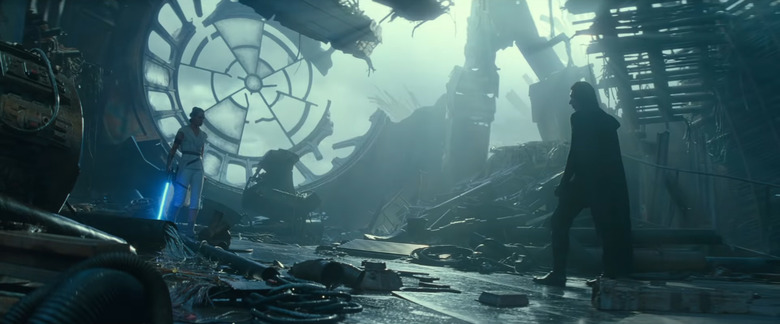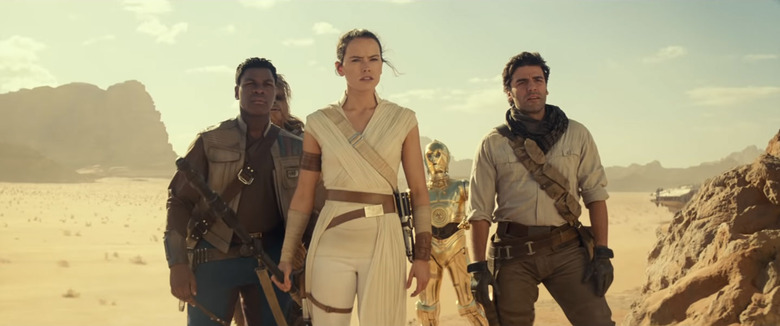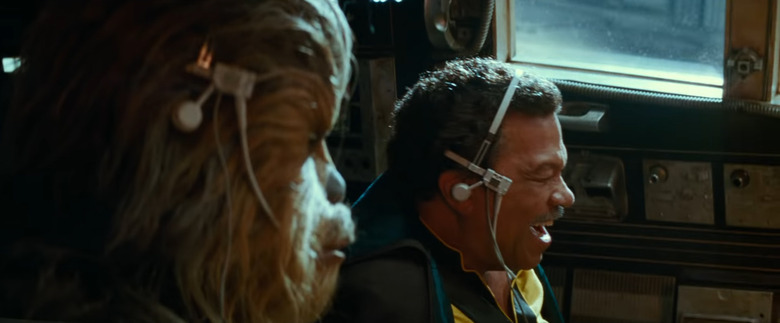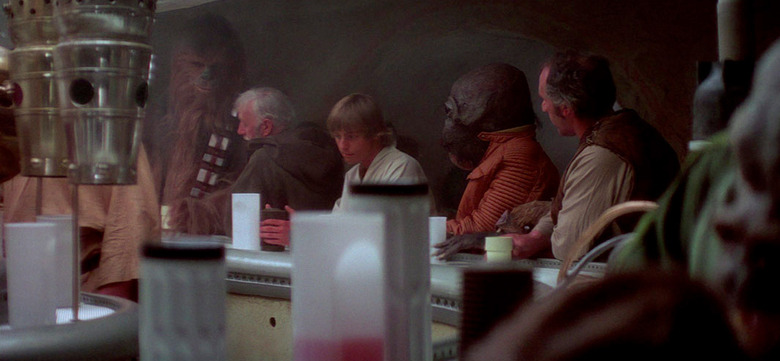How 'The Rise Of Skywalker' Draws On Previous Threads To Conclude The 9-Episode 'Star Wars' Saga
Star Wars: The Rise of Skywalker has sent the Internet into an uproar, but amid the ping-ponging hot takes — all of which are right, "from a certain point of view" — it's worth pausing to remember that this movie brings a close to a saga dating back to 1977. The 9-episode Skywalker Saga has served up its denouement the same year as that of Marvel's 23-episode Infinity Saga. Avengers: Endgame also had a lot of threads to tie off, but it did so in a manner that caused less of a disturbance in the Force. Most Marvelites seem to have gone home happy back in late April. Is it even possible anymore for Star Wars to appease its opinionated, cross-generational fan base like that?
The fates are always dueling and it is your destiny as Jedi or Sith apprentices to make up your own mind about what you saw when The Rise of Skywalker opened in theaters around the globe. I have my own opinions about the movie, but I've said my piece in a separate spoiler review and am happy to keep this discussion compartmentalized from that one.
Star Wars once staked out Memorial Day weekend as its piece of box-office territory. The release of a new George Lucas space opera traditionally meant the start of the summer movie season. But in the Disney era, the franchise has shifted to Christmas-y December releases. For the purposes of this analysis, I'll try to try to tap into some yuletide cheer and keep the tone as neutral as possible. If you think The Rise of Skywalker hasn't been getting a fair shake and are looking for a more even-handed perspective, you don't need to worry about hearing someone else trash it here as we examine how it wraps up the Skywalker Saga.Spoilers below for The Rise of Skywalker.
As it ends the saga, the threads that Episode IX draws together aren't always plot threads. More often than not, it's visual threads from previous movies that are sewn throughout its 142-minute runtime. George Lucas famously viewed Star Wars as poetry, complete with rhymes. Fans with a good photographic memory should be able to spot many such rhymes in The Rise of Skywalker, amid an array of familiar plot points that director J.J. Abrams uses in a bid to keep up recurring motifs (or establish them as part of his ongoing remix approach to this and other film franchises set in the stars).
Rey and Ren: From “No One” to “Sometwo” Special
The biggest new link that The Rise of Skywalker offers to the original and prequel Star Wars trilogies is the return of Emperor Palpatine, whose name pops up right away in the opening crawl. "The dead speak!" Kylo Ren goes to meet the Emperor on a planet in the Unknown Regions called Exegol, where we see his supply of Snoke clones floating in liquid tanks. Palpatine quotes himself from the opera scene in Revenge of the Sith when he says, "The Dark Side of the Force is a pathway to many abilities some consider to be unnatural."
That was the same scene where he related the Tragedy of Darth Plagueis the Wise, the Sith legend that established a precedent for possibly cheating death in the Star Wars universe. Throughout the movie, we'll hear other lines of dialogue repeated from earlier films, such as C-3PO's self-introduction ("I am C-3PO, human-cyborg relations,") and the classic uh-oh mantra, "I've got a bad feeling about this."
Palpatine also warns Kylo Ren about Rey, telling him, "She is not who you think she is." It turns out Rey is Palpatine's granddaughter, and that's why she's so powerful, able to manifest Force lightning, even before she's learned the secret of her Sith bloodline. This sort of rejiggers the Skywalker Saga as the Skywalker and Palpatine Saga, since both a Skywalker and a Palpatine have been present as the central protagonist and/or antagonist of every movie. Kylo Ren fills in more of the details about Rey's parents later, telling her, "They chose to be no one to keep you safe. They sold you to protect you."
The rhymes continue as we see Rey climb through the wreckage of the floating Death Star, echoing our introduction to her in The Force Awakens, when she's scavenging parts in the crashed Star Destroyer on Jakku. The Emperor's old throne room is still intact enough for her to revisit the scene of the climactic lightsaber duel in Return of the Jedi. She soon meets and fights an evil version of herself, like Luke Skywalker on Dagobah. Evil Rey's double-sided red lightsaber is pure Darth Maul. (This is your reminder that Darth Maul might still be out there somewhere, showing off his Sith manspread and cybernetic legs along with said lightsaber.)
I saw The Rise of Skywalker twice on opening weekend. Coming out of it the second time, I was with my wife, and since I had already had time to digest it once and knew how I felt, I was more interested to hear her thoughts. She responded most favorably to Rey's storyline. She liked how it resolved the question of her parentage, putting to bed the notion that she was "no one" (as Kylo Ren once called her) and making her "someone special" (as my wife put it). The missus is more of a casual moviegoer, but after listening to her thoughts, I offered a few of my own, talking a bit about the Chosen One trope in mythology and how The Last Jedi had tried to subvert that in favor of a Force that was accessible to anyone, not just Skywalkers and Palpatines.
The differing viewpoints on which is better, "no one" or "someone special," are probably the crux of the biggest argument surrounding The Rise of the Skywalker right now. The funny thing is, technically, Rey isn't just someone special. She's one half of a new-fangled Force Dyad, what the Urban Dictionary would call a special "sometwo."
The other half is Kylo Ren, and if you were hoping to see Ben Solo redeemed, The Rise of Skywalker goes that direction. After stabbing him with her lightsaber and inadvertently killing his mother, Leia, in the process, Rey uses her new healing powers to save Ren, who now reverts to his Ben state. Ben confers with the memory of Han (a returning Harrison Ford), but he's not through being put through the wringer: he'll soon have to face his own returning Knights of Ren in combat.
He rushes to be by Rey's side on Exegol, where the ceiling of the Emperor's new throne room opens up to reveal a view of the starship battle overhead. This moment is similar to beats in Return of the Jedi and The Last Jedi in which we saw Luke and Rey, respectively, looking out the space window in Palpatine and Snoke's throne rooms.
After defeating the Emperor, the sexual tension between Daisy Ridley and Adam Driver's characters comes to a head in the form of a single kiss. Ben Solo transfers some of his life force to Rey to bring her back to life, then he dies and dematerializes like Obi-Wan Kenobi, Yoda, and Luke. The movie ends with Rey adopting Skywalker as her family name, then looking out over Tatooine at another binary sunset, just like Luke did in A New Hope and The Last Jedi.
Three Heroes, Together Again for the First Time
Let's backpedal a bit from the movie's ending. Rey and Oscar Isaac's Poe Dameron only just met at the very end of The Last Jedi, but when we catch up with them again in The Rise of Skywalker, they've formed a bickering dynamic that recalls the one between the three leads in the original Star Wars trilogy: Mark Hamill, Harrison Ford, and Carrie Fisher. Poe and John Boyega's Finn are more buddy-buddy. They team up against Chewbacca for Dejarik, or holochess, aboard the Millennium Falcon, which has its original round radar dish back on after the square replacement was destroyed in The Last Jedi.
Not much has changed for Wookiees as Dejarik players. They're still poor sports and Chewie may even be a cheater, but Poe ameliorates him by paying lip service to his age and concomitant holochess skill. It's a reminder that Chewbacca was around even for the Battle of Kashyyyk in Revenge of the Sith. Like C-3PO and R2-D2, he's been there at the end of all three trilogies.
Finn and Poe do share one camaraderie-testing moment, like the one where Luke became briefly disillusioned with Han for abandoning the Rebels prior to their assault on the first Death Star. In this case, it's because Finn wants to go after Rey, who has just sailed off, all by her lonesome, to the floating remains of the second Death Star on Kef Bir, a moon of Endor.
Speaking of Death Stars, while there's no Starkiller Base in this movie (and thank the Maker for that), we do see the three leads running around in halls, shooting their way through Stormtroopers, as they attempt to pull off a daring rescue on a Star Destroyer. This time, it's a kidnapped Chewie who needs freeing, not Princess Leia. The Millennium Falcon sits in a docking bay on the Star Destroyer, just like it did on the Death Star in A New Hope. General Hux even channels Grand Moff Tarkin, using "terminate" as a euphemism for "kill" when he's giving orders. The only thing that's missing, really, is a scene where Finn kisses Rey "for luck," then holds onto her as she swings them both across an echoey chasm.
Finn and Rose Tico kissed at the end of The Last Jedi, but Rose is mostly sidelined in this movie and in their few short interactions, there's no readily apparent spark of romance. When our heroes face the prospect of dying in black quicksand on a desert planet (not Tatooine or Jakku, but Pasaana this time), Finn seems on the point of confessing his love to Rey...or his Force-sensitivity, which is an interpretation that Abrams has put forth. (The original Twitter user who related his comment to a fan at a screening of the film has since clarified that he said he "purposely left it open-ended" to allow for other interpretations.) Whatever his secret is, Finn never gets to finish telling Rey, and even a Stormtrooper firing squad can't coax it out of his lips for his nosy pal Poe to hear. Later, Finn is seen bonding with Jannah, a new character with a similar background as a deprogrammed Stormtrooper.
On Pasaana, the Festival of the Ancestors, with its "colorful kites and delectable sweets," only takes place every forty-two years. That's as long as the Star Wars franchise has been around. At one point, the chase through the canyon on Pasaana incorporates an aerial shot that mirrors the visuals of the podracers speeding through the canyon in The Phantom Menace.
Star Destroyers with underbelly cannons keep up the franchise's planet-destroying tradition. The unlucky world that gets destroyed in this movie is Kijimi, where Poe meets an old bounty hunter flame, Zorri Bliss, and we learn that he was once a spice runner, like Han.
Lando and Luke, Jedi Voices, and Planets Past
For old-school fans of the original Star Wars trilogy, the biggest highlight of The Rise of Skywalker may be seeing Billy Dee Williams back as Lando Calrissian — the fourth Musketeer, who never got so much as a mention in The Force Awakens or The Last Jedi. Williams looks good, and whereas Carrie Fisher (R.I.P.) has been a constant presence throughout the sequel trilogy, having Lando back helps buoy this movie with the presence of a new-old character, à la Ford in The Force Awakens and Hamill in The Last Jedi.
Lando appears in a desert disguise at first, just as he did in Return of the Jedi. The enigmatic scene where he sits down with Jannah at the end of the movie makes a whole lot more sense if you're aware of the missing pieces of his backstory, which didn't make it into the film and are only known because of Pablo Hidalgo's companion book, Star Wars: The Rise of Skywalker – The Visual Dictionary. When Lando shows up at the end to save the day, he's back in the pilot's seat of the Millennium Falcon, wearing the yellow shirt that we identify with his younger Solo-era self. He finally got his ship back. It only took the death of his old buddy, Han, to make it happen.
As you might expect given past blue reappearances of Obi-Wan and all, Luke shows back up as a Force ghost on Ahch-To. He's not about to do any more lightsaber-tossing, however. In fact, this time he catches the lightsaber that Rey has thrown, telling her that he "was wrong" and giving her a little pep talk before raising his X-Wing Fighter out of the water — something he was never able to do back in the Dagobah swamp. In this scene and the throne room scene on Kef Bir (and probably several other scenes that I'm forgetting), composer John Williams utilizes familiar music cues from the original Star Wars trilogy.
Luke's appearance in this movie winds up being more of a quick walk-on, but there are other "voices of Jedi past" (as they're billed in the closing credits) that Rey hears before she rises up to defeat the Emperor. If you prick up your ears, you'll catch voice cameos from Frank Oz as Yoda, Ewan McGregor and Alec Guinness as Young and Old Obi-Wan, Liam Neeson as Qui-Gon Jinn, Hayden Christensen as Anakin Skywalker, and Samuel L. Jackson as Mace Windu. There are also cameos from several voice actors who appeared on the two animated series, The Clone Wars and Rebels, though I'm not as familiar with either of those shows beyond knowing that Freddie Prinze, Jr. played a character named Kanan on one of them. (Read more about the rest of the film's cameos here and here.)
A parade of planets, new and old, joins the chorus of voices in capping off Disney's sequel trilogy and the Skywalker Saga. Though it's easy to miss, the planet at the beginning of The Rise of Skywalker — where Kylo Ren strikes down unnamed foes and obtains the pyramidal Sith Wayfinder — is actually Mustafar, the lava planet from Revenge of the Sith and Rogue One: A Star Wars Story. It's where Anakin lost his lightsaber duel to Obi-Wan and got so badly burned that he had to be put into his Darth Vader suit to survive. Vader's castle was also on Mustafar, but again, you'd have to read the ancillary material, Hidalgo's Visual Dictionary, to recognize the connection being made to it in this scene. Is that fair? Not really, but it gives the more dedicated fans an Easter egg to find.
Having hopped around to numerous new planets and moons and revisited old sequel trilogy locations like Mustafar and Ahch-To, The Rise of Skywalker ends by checking back in on Cloud City from The Empire Strikes Back and the forest moon of Endor where the Ewoks dwell. Wicket W. Warrick is still very much alive and furry. Jakku also makes a cameo as the movie mimics the inserted shots of galaxy-wide celebrations in the Special Edition version of Return of the Jedi.
That about does it for me with The Rise of Skywalker, but as Andy Dufresne once said, "If you've come this far, maybe you're willing to come a little further." Episode IX, this unwieldy blockbuster called The Rise of Skywalker, has put a polarizing bow and ribbon around the gift that George Lucas and his cast and crew gave when they first put Star Wars out into the world some forty-two years ago and counting. Call me crazy, but that, in and of itself, seems like a kind of unintentional callback, one that brings the franchise back to 1999 when people first saw The Phantom Menace in theaters and started getting upset about it.
In the spirit of the holiday season, I would like to add a little postscript about the general state of Star Wars in the immediate aftermath of The Rise of Skywalker. If you're game for that, follow me over to the cantina corner and let's grab a drink of blue (or green) milk for the road.
Cantina Corner: The Art of Healthy Detachment
Here's the thing. I mentioned my wife before (isn't that cute? He's got a wife), and she actually expressed enjoyment of The Rise of Skywalker upon leaving the theater. Me? Not so much. We were, however, able to have a civil conversation about it and stay married...because we're adults. By writing this whole long article and couching my dislike in a glimmer of fair-mindedness, I also wanted to show that it's possible to rationally discuss a movie you don't like — in great depth, as it turns out — without going for the throat of anyone. I wasn't nearly as kind in my spoiler review of The Rise of Skywalker, so maybe that makes me a hellbound hypocrite; but even with that review, I tried to focus my criticism as much as possible on the movie itself and not engage in any extended personal attacks on Abrams or the other fine folks responsible for this film, all of whom probably have more talent and good character in their little fingers than I could ever hope to conjure up with any chain of words that I might release into the Internet vacuum.
In any fan community — and the human race in general — there are going to be healthy and unhealthy pockets of people interacting at all times. The fandom menace (here used as a general term, not to be confused with any YouTube channels that go by that name) is not a phenomenon that's limited to Star Wars, by any means. Earlier this year, I wrote about the premillennial anime Neon Genesis Evangelion and the new religion of 21st-century fandom. The very first thing I said is that fandom is a religion that thrives on killing its own gods.
That's the gospel of the new century. I'm as caught up in it as anyone else. Deicide forms the core of at least one major world religion, and since George Lucas consciously designed Star Wars as a permutation of the monomyth and Joseph Campbell's The Hero with a Thousand Faces, it's not hard to see it or any other rabid fandom as a new secular god-killing religion.
Woe betide the film franchise that forgets its deicidal fate, for the law of increasing fan entropy states that every beloved geek franchise shall become a victim of its own success. The franchise stewards just can't seem to leave well enough alone, and neither can we, so they make more movies and we subject them to the impossible standard of a fairy tale that we remember from childhood. A long time ago, in a galaxy far, far away...
We've subjected Star Wars to that standard for a solid two decades now, ever since George Lucas unleashed The Phantom Menace on the world in '99. It was cute when they made a documentary called The People vs. George Lucas, but in retrospect, maybe we shouldn't have all ganged up on George because it set a precedent that has continued with people railing against "Ruin Johnson" and whatnot. The moral of the story: the inner child is fickle, emotion runs high among fans, and I imagine The Rise of Skywalker will be fueling debate for years to come.
Personally, I've long since resigned myself to the notion that Star Wars means too many things to too many different nerf-herders on this backwater blue planet where we live. As a diehard fan of the original trilogy, I used to harbor more ill will toward the prequels. Now, I'm just indifferent about them, mostly. If you like them, my attitude is: hey, whatever floats your tribubble bongo. I need not concern myself with them if it means calling up negative emotions: fear, anger, hate, suffering...all the things Master Yoda warned about as he tried to lead Luke down the quasi-Buddhist path of Jedi enlightenment.
It's good to be passionate about things, and of course, I'm speaking as someone who has already gotten his thoughts out of his system. But maybe those of us who are not too enamored with the prequels or certain sequels should make it our New Year's resolution to explore the concept of indifference — Zen and the art of healthy detachment. Star Wars is a big enough empire of dreams that it can accommodate everyone staking out their own cantina corner without needing to shoot each other or yell "Maclunkey!" Jar Jar Binks can't hurt me anymore, unless I let the thought of his yellow eyes into my mind...and why would I do that unless I wanted to investigate the gangly Gungan as a possible reverse-Yoda with Sith ties?
As a fan, The Rise of Skywalker reaffirmed, in a less amicable fashion, the breakup feeling that I felt following Solo: A Star Wars Story. In real life, my marriage happened to come last year just after the opening weekend of Solo, a movie that washed over me once and then receded like the Ant-Man of the Star Wars franchise: light and casual, enjoyable but inconsequential. This confluence of events, the marriage and the movie, helped me come to terms with growing up and letting go of Star Wars. 1 Corinthians 13 is a common Bible reading for weddings; there's a line in there about becoming an adult and putting away childish things. That's how the fan in me, who will always be a kid at heart, felt as he adjusted to life after Luke, the greatest Star Wars character.
The most spot-on criticism I've heard of The Last Jedi is that it played more like a last chapter than a middle chapter. Anything serialized long enough puts me on the lookout for jumping-off points, and The Last Jedi provided a big one by showing Luke Skywalker fade away in the glow of that binary sunset, forty years after he first surveyed one in A New Hope. The last scene with Broom Boy (I'm aware he has a name, but like Baby Yoda, Broom Boy shall forever be the preferred nomenclature for him) effectively democratized the Force, showing that it belonged to everyone, not just the offspring of little boys named Anakin with a high midi-chlorian count.
Just last month, HBO's Watchmen, another nine-episode saga helmed by a Lost alumnus, aired an episode with the instructive title of, "If You Don't Like My Story, Write Your Own." As kids, that's what we did with Star Wars action figures. If you liked The Last Jedi's ending, if you thought it was an appropriate sendoff to the Skywalker saga, you can always ignore The Rise of Skywalker. Or you can choose to wholeheartedly embrace what J.J. Abrams has done with his actorly action figures. Or you can throw up your hands, call the whole thing off, and ignore every Star Wars movie since 1983. You'll always have the original trilogy (in, er, Special Edition form.)




